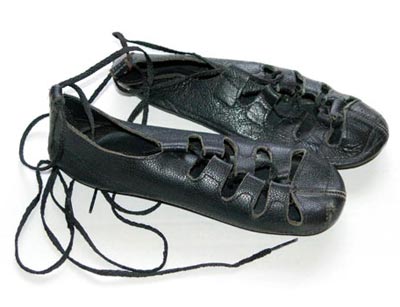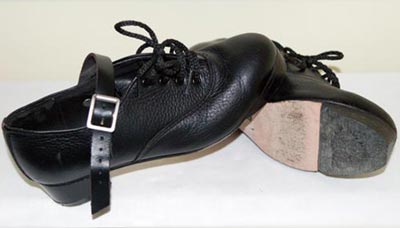Irish Step Dancing - History
The origin of Irish dancing is subject to much debate, Travelling dance masters in the 18th and 19th century are believed to have introduced step dancing to Ireland. Immigrants keen to continue their heritage and culture brought Irish dancing to to America, Australia and England as they were forced to leave Ireland particularly after the Great Famine of the 1840's. Irish step dancing has changed over the years, step dancers in the 18th and 19th century wore their 'Sunday best'. Dancers would simply wear the outfit that they normally wore to church and dance bare foot. For dances such as the Hornpipe which required hard shoes, metal panels and even nails would have been attached to the sole of the dancers own shoes to allow them to make the 'bangs' and 'taps' required. In the 1970's and 1980's solo step dancers began to wear heavy a-line dresses embroidered with a variety of Celtic patterns and specialist dance shoes were made specifically for Irish dancers.Irish Step Dancing - Competitions
The first 'Feis' (Festival) was organised by Conradh na Gaelige in Macroom, County Cork in 1898. Conradh na Gaelige also known as the Gaelic League was formed in 1893 and its aim was to promote the Irish culture, particularly spoken Irish and Irish literature. Conradh na Gaeilge was also responsible for promoting other areas of Irish culture particularly Irish dancing. The Gaelic league organised the establishment of dancing classes all over Ireland and even set up classes for the children of Irish Immigrants in Boston and London in the early 1900's. The London branch of Conradh na Gaeilge was founded in 1894.The Irish dancing commission known as 'An Coimisium le rinci Gaelacha' was established to promote Irish dancing and the World Irish dancing championships (Oireachtas Rince na Cruinne) were established in 1970. Until 2000 the championships were held annually in the Republic of Ireland. However in 2000 the world championships were held outside the republic for the first time in Belfast, Northern Ireland. Since then they have been held all over the world due to the global popularity of Irish dancing. Different types of Irish Step Dancing
There are two types of dancing, Solo step dancing and Ceili set dancing which is danced as a team. Solo step dancing is mainly about steps, known as footwork. Irish step dancers keep their upper body as still as possible and their arms are held by their side. Timing and rhythm are vital and the sheer speed of dancing is breath taking. Irish Step Dancing - Shoes
Different dances require the dancer to wear different shoes. There are two types of dancing shoes used by solo Irish step dancers these are soft shoes (also referred to as ghillies) and hard shoes (often referred to as Hardies), both types of shoe are pictured below:  Irish Step Dancing - Soft Shoes |
 Irish Step Dancing - Hard Shoes |
Irish Step Dancing - Hard Shoes for Dancing
The heavy or hard shoes worn by Irish step dancers hard shoes are very similar to tap shoes. They are however much bulkier and the toes and heels are made of fibreglass to increase the sound level. Hard shoes are used when dancing traditional step dances such as the Hornpipes or Treble jig. The click made by the shoes is an important part of the dance. Picture of an Irish Step Dancing Hard Shoes Irish Step Dancing - Soft Shoes for Dancing
The image below shows a pair of soft shoes worn by female Irish solo step dancers. The shoes are know by a variety of different names including ghillies, light shoes and pumps. The shoes are very similar in design to ballet pumps but tie with laces instead of elastic. Many young step dancers use ballet shoes when they first start Irish dancing lessons, this allows the parents to see if their child is keen to continue with lessons as ballet pumps are much cheaper than soft shoes. It is generally a good idea to check with your child's dance teacher to see if they keep a stock of second hand ghillies. Children's feet grow so quickly, it can be very expensive to buy new dance shoes every few months. Ghillies are also worn by women in Scottish Highland dance and men in Scottish Country dancing! Soft shoes are made in leather with long laces that criss-cross across the front of the shoe, often wrapped around the sole of the foot before being tied like a sneaker or trainer in a bow. Unlike other lace up shoes the laces are fed through slots in the leather and not eyelets.  |
Picture of an Irish Step Dancing Soft Shoes Irish Step Dancing - Costumes
The dancing dresses worn by step dancers today are designed to the dancers individual taste and each one is unique. Different colors, patterns and materials ensure that each individual solo step dancer stands out from the crowd. Apart from dresses, wigs are also worn by dancers and fake tan, make up and tiaras are also common place. This is vastly different from the early 1900's when the Gaelic league (Conradh na Gaeilge) was formed to promote Irish culture and heritage, then the design of the dresses were based on the style of dress worn by Irish peasants. The Irish dancing industry has however moved with the times and large competitions (Feis) are held in huge arenas and theatres complete with proper stages and lighting. The dancers of today who compete at country and world level need to stand out from the crowd with their flamboyant dresses fake tan, make up and tiaras! Picture of an Irish Step Dancing Costume
Irish Step Dancing - Why do dancers wear wigs?
Irish step dancers have to keep their body rigid whilst dancing, this does not apply to their hair! The bounce of curls can emphasise the height of the jumps and allow the step dancer to be more expressive. Traditionally girls hair was kept long and those with straight hair always had their hair styled into ringlet curls in advance of a dancing competition. This was often the worst part for the girls, having to sleep with uncomfortable 'rollers', 'curler's' or 'rags' in their hair overnight. Nowadays wigs are commonplace and worn by Irish dancers performing at competitions all over the world. Wigs are a very popular choice for those with short or naturally straight hair and preferred in place of the uncomfortable curlers. The dancing wigs are very realistic and can be made to suit the color of the dancers individual hair color.
Traditional Image of Irish Step Dancing Benefits of Irish Step Dancing
Irish step dancing is not just about footwork and beautiful dancing costumes! Although the step dancers move their feet at a breathtaking rate and their costumes are amazing, timing and rhythm is also extremely important. Other benefits getting involved in Irish step dancing classes are: Increased Physical Fitness Improved Co-ordination Fantastic and fun exercise Increased concentration levels Helps form a competitive spirit Builds self esteem Helps to improve stage presence Promotes Irish Culture Friendship amongst dancers attending lessons
|